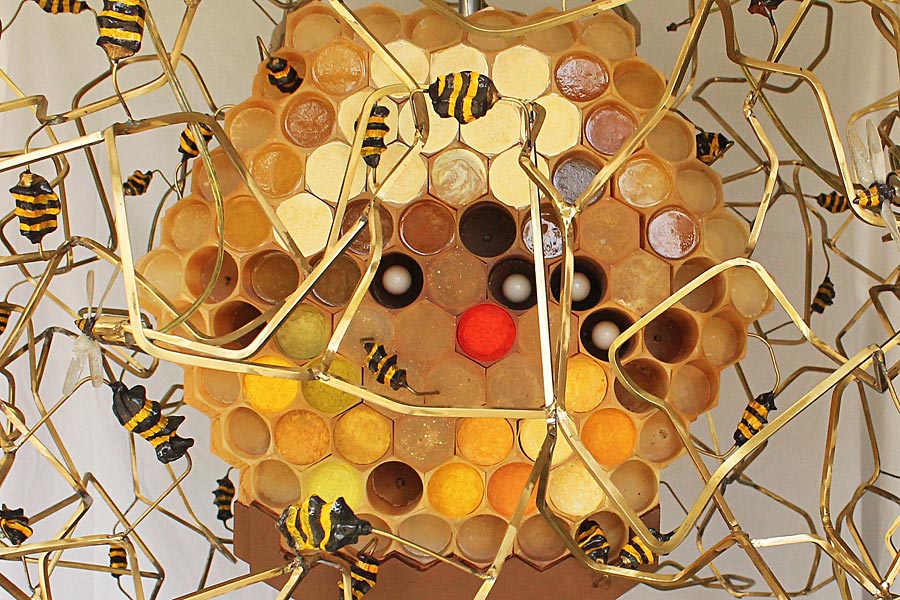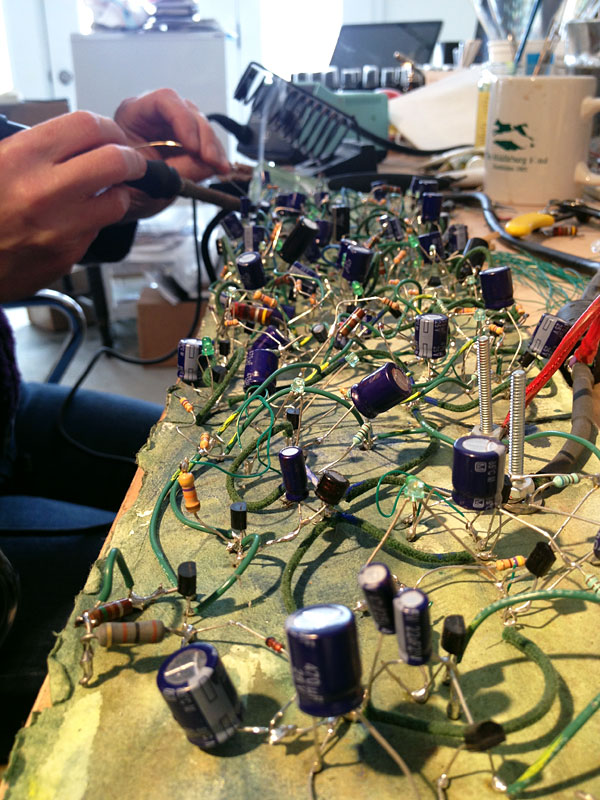electricity
open studio: the shrine of enlightenment through diminishing resistance /
The Shrine of Enlightenment through Diminishing Resistance. Kelly Heaton, November, 2015
Here's another vignette from The Electronic Sculpture Garden. An important facet of the relationship between people and electronics is the profound realization that everything is energy. Energy flows through our bodies, is transformed in an orderly fashion to produce work, and therefore we are alive. Energy flows through a circuit, is transformed in an orderly fashion to produce work, and therefore the circuit is "live." A better understanding of electronic design is a path to better understanding of our own beingness. In this little sketch, energy flows through resistors that have been painted with the colors of an eastern Bodhisattva. The controlled current and voltage drop across LEDs creates light,similar to the aura that emanates from an enlightened being.
open studio: electronic sculpture garden /
A couple look at the green light emitted by an astable multivibrator living in the Electronic Sculpture Garden. In the background, a child plays with a ceramic capacitor while two transistors look on. Kelly Heaton, November 2015
Image description from left to right: (1) Entering the garden through one of four analog logic gates, in this case, the logical AND gate. The colors of the resistors in the gate were chosen in honor of France. (2) A scene with woman and child enjoying the garden. The woman sits on a microprocessor, meanwhile her child plays tries to climb onto a vintage resistor. A transistor and capacitor are in the background. (3) A woman regards a dead microprocessor. In the background, a transistor is being overgrown by a twisting vine. Other electronics have organic, natural forms that make them hard to distinguish from the surrounding vegetation. (4) Detail of a vine overgrowing a transistor in a post-apocalyptic vision of the Electronic Sculpture Garden.
NOTES
I continue to create vignettes of my Electronic Sculpture Garden using miniatures and photography to convey a built environment. Why am I doing this? I want to bridge the consciousness gap between man and machine, to pull back the curtain of Oz, and especially to raise human understanding of the electronics that pervade modern industrialized cultures. Most people are curious about how things work, but are uninterested in a steep learning curve. Understanding electrical engineering is steep indeed. Electronic components are tiny and foreign, like characters in a strange alphabet. Their energy-transforming behaviors are largely invisible, and circuit diagrams are gibberish to the untrained eye. Even well-documented circuitry can be difficult to analyze and comprehend. Thus, electrical engineering is pigeon-holed as geeky, meanwhile people of every generation, gender and nationality are becoming dependent on electricity (==God save us if the grid goes down for any length of time).
Meanwhile we become dependent on manmade electronics, humanity is transforming the natural environment of earth. Nature is truly the pinnacle of sophisticated electronic design: people, like all biological organisms, are energy consuming, transforming and expending machines. One could argue that there’s no real distinction between nature and electronics because both are systems for energy transformation. The real distinction concerns the maker: Man versus God or Nature (or whatever Entity you believe to be the creator of things not made by humans).
Why a garden? People seem to have an easier time relating to things on our same physical scale. Human-scale sculpture of electronic devices situated in a grassy landscape would be a playful and intriguing experience, like concrete dinosaurs in an amusement park. Barriers to understanding (and prejudices against electronics) would -hopefully- be less than usual. The green of a garden can be compared with the green of a classic circuit board, and everyone feels comfortable on a lawn. Situating electronic sculpture within a formal garden is an opportunity to define the landscape in an entirely new way, yet draws upon a centuries-old tradition of gardens with fantastical sculpture. In short, big electronic sculpture in a modern garden is cool.
Another facet of garden design that interests me is the relationship between Man and Nature in the Anthropocene. Here, I have more questions than answers... Electronics transform energy, plants transform energy, but are they both alive? As manmade objects increase in sophistication, will they eventually become as living as natural systems, even competing or merging with nature? What happens when humans stop making electronic things (for example, due to an apocalypse); will "original" or "true" natural reclaim manmade artifacts, eventually composting most or all trace of human ingenuity? I love the idea of vines twisting up the legs of a transistor, or flowers growing within a patch of resistors. The visual effects are beautiful and intriguing, as are the conceptual implications.
I will continue to explore these ideas in the design of my Electronic Sculpture Garden, and I will eventually publish a book with my findings.
open studio: electronic sculpture garden /
One my early studies for a sculpture garden that blends nature, electronics and people. Kelly Heaton, November 2015
As usual, I am working on several projects in parallel. My mind refuses to stay contained within a discipline or focused on a single task for more than a few days (or a few hours)... so I no longer try. Anyway, it seems that everyone is becoming "attention multiplexed."
As we enter into the Anthropocene, the era in which human activity shapes the geologic history of Earth, the distinction between nature and technology is increasingly blurry. Nature has an ecology, electronics have an architecture, and both are systems for the distribution of energy. The merging of living systems fascinates me.
One of my new projects is to design a grand garden that is modeled after a circuit board, to weave landscape architecture and electrical engineering into a functional, natural circuit. The sculptures in the garden will be human-scale electronic devices, enabling visitors to "meet" technology face-to-face, and to walk the pathways within the circuit. Some elements of the garden will be formal, recalling classic electrical engineering on the tidy green "lawn" of a printed circuit board. Wilder areas of the garden will play with nature and technology as (a)live, interconnected, and dissolving into one and other over time. I love the idea of trees building a subterranean circuit with their roots; soil churning with chemical, fungal and animal messengers; vines growing over electronics like unruly wires; cisterns that collect water from the sky, feeding channels and powering kinetic mobiles; and shrines that worship Gods of Power, be it natural or manmade.
news: solo show announcement /
Detail of "The Beekeeper," 2015. Kinetic sculpture made with steel, cast resin, brass, electronics, wood and paint. Approximate dimensions are 60"(W) x 132" (H). Kelly Heaton
I am pleased to announce that my latest body of work, "Pollination," will open on September 12 at Ronald Feldman Fine Arts, 31 Mercer Street, NYC. The show addresses many facets of pollination as a fertile exchange, including bees, commerce, human relationships, spirituality and technology. Works include large-scale sculpture, kinetic sculpture, works on paper and perfume. A public reception will be hosted at the gallery on September 12 from 6 - 8pm. The show runs through October 24.
For more information, please sign up for my mailing list or contact Ronald Feldman Fine Arts: (212) 226-3232.
open studio: giant transistor with dog in winter landscape /
This 6 foot tall steel rendering of an NPN transistor is a work-in-progress for a sculpture titled "Colony Collapse Disorder," premiering September 12th at Ronald Feldman Fine Arts as part of my Pollination show. The snow and dog are irrelevant save for: packed snow was a convenient medium to make the transistor stand upright for the photo and my old dog, Spivey, provides a sense of scale. For those electronics geeks among you, yes, the NPN transistor is raising its leg to become a diode. Spivey doesn't raise her leg because she is a girl.
open studio: making a big bee resistor /
The process of making a larger-than-life resistor, modeled by hand to look like a bee
Big bee resistor after epoxy buddy is applied and sculpted. Next, the sculpture will be painted
open studio: electrifying the wedding tree /
Building the circuit for The Wedding Tree (work-in-progress). Analog electronic components are pegged through heavy watercolor paper and soldered together to drive LEDs and pager motors. Photo credit: Sarah Loy






















